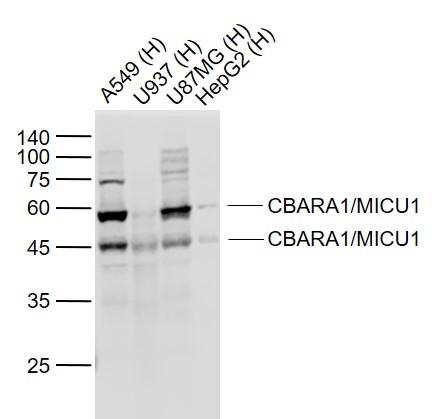
Mouse Anti-CBARA1/MICU1 antibody
Mitochondrial Calcium Uptake 1; Calcium-Binding Atopy-Related Autoantigen 1; Atopy-Related Autoantigen CALC; Ara CALC; CBARA1; CALC; Calcium Binding Atopy-Related Autoantigen 1; Calcium Uptake Protein 1, Mitochondrial; Allergen Hom S 4; EFHA3; MPXPS; MICU
View History [Clear]
Details
Product Name CBARA1/MICU1 Chinese Name Mitochondrion钙吸收蛋白单克隆抗体 Alias Mitochondrial Calcium Uptake 1; Calcium-Binding Atopy-Related Autoantigen 1; Atopy-Related Autoantigen CALC; Ara CALC; CBARA1; CALC; Calcium Binding Atopy-Related Autoantigen 1; Calcium Uptake Protein 1, Mitochondrial; Allergen Hom S 4; EFHA3; MPXPS; MICU1_HUMAN; Research Area Cell biology Signal transduction The new supersedes the old Mitochondrion Immunogen Species Mouse Clonality Monoclonal Clone NO. 1H8 React Species Human, (predicted: Mouse, Rat, ) Applications WB=1:500-1000
not yet tested in other applications.
optimal dilutions/concentrations should be determined by the end user.Theoretical molecular weight 54kDa Cellular localization cytoplasmic Mitochondrion Form Liquid Concentration 1mg/ml immunogen Recombinant human CBARA1 Protein (1-250/476) Lsotype IgG Purification affinity purified by Protein G Buffer Solution 0.01M TBS(pH7.4) with 1% BSA, 0.03% Proclin300 and 50% Glycerol. Storage Shipped at 4℃. Store at -20 °C for one year. Avoid repeated freeze/thaw cycles. Attention This product as supplied is intended for research use only, not for use in human, therapeutic or diagnostic applications. PubMed PubMed Product Detail This gene encodes an essential regulator of mitochondrial Ca2+ uptake under basal conditions. The encoded protein interacts with the mitochondrial calcium uniporter, a mitochondrial inner membrane Ca2+ channel, and is essential in preventing mitochondrial Ca2+ overload, which can cause excessive production of reactive oxygen species and cell stress. Alternatively spliced transcript variants encoding different isoforms have been described. [provided by RefSeq, Mar 2013]
Function:
Key regulator of mitochondrial calcium uniporter (MCU) that senses calcium level via its EF-hand domains (PubMed:20693986, PubMed:23101630, PubMed:23747253, PubMed:24313810, PubMed:24332854, PubMed:24503055, PubMed:24560927, PubMed:26341627, PubMed:26903221, PubMed:27099988). MICU1 and MICU2 form a disulfide-linked heterodimer that stimulates and inhibits MCU activity, depending on the concentration of calcium. MICU1 acts both as an activator or inhibitor of mitochondrial calcium uptake (PubMed:26903221). Acts as a gatekeeper of MCU at low concentration of calcium, preventing channel opening (PubMed:26903221). Enhances MCU opening at high calcium concentration, allowing a rapid response of mitochondria to calcium signals generated in the cytoplasm (PubMed:24560927, PubMed:26903221). Regulates glucose-dependent insulin secretion in pancreatic beta-cells by regulating mitochondrial calcium uptake (PubMed:22904319). Induces T-helper 1-mediated autoreactivity, which is accompanied by the release of IFNG (PubMed:16002733).
Subunit:
Homohexamer; in absence of calcium (PubMed:24514027). Forms a homohexamer in absence of calcium and rearranges into a heterodimer in presence of calcium (PubMed:26489515, PubMed:24514027). Heterodimer; disulfide-linked; heterodimerizes with MICU2 (PubMed:24560927). The heterodimer formed with MICU2 associates with MCU at low calcium concentration and dissociates from MCU at high calcium level (PubMed:26387864). Component of the uniplex complex, composed of MCU, MCUB, MICU1, MICU2 and EMRE/SMDT1 (PubMed:24231807). Interacts (via polybasic region) with EMRE/SMDT1; the interaction is direct (PubMed:27099988). Interacts (via polybasic region) with MCU (via coiled coil domains); the interaction is direct and precedes formation of the heterodimer with MICU2 (PubMed:21685886, PubMed:23101630, PubMed:23178883, PubMed:24332854, PubMed:26387864). Interacts with SLC25A23 (PubMed:24430870). Interacts with CHCHD4/MIA40; which introduces the interchain disulfide bond with MICU2 (PubMed:26387864).
Subcellular Location:
Mitochondrion inner membrane; Single-pass membrane protein; Mitochondrion intermembrane space
Tissue Specificity:
Expressed in epithelial cell lines. Strongly expressed in epidermal keratinocytes and dermal endothelial cells.
Similarity:
Belongs to the MICU1 family. MICU1 subfamily.
Contains 2 EF-hand domains.
SWISS:
Q9BPX6
Gene ID:
10367
Database links:
Entrez Gene: 10367 Human
Entrez Gene: 216001 Mouse
Omim: 605084 Human
SwissProt: Q9BPX6 Human
SwissProt: Q8VCX5 Mouse
Unigene: 524367 Human
Unigene: 27199 Mouse
Unigene: 214252 Rat
Product Picture
Lane 1: A549 (Human) Cell Lysate at 30 ug
Lane 2: U937 (Human) Cell Lysate at 30 ug
Lane 3: U87MG (Human) Cell Lysate at 30 ug
Lane 4: HepG2 (Human) Cell Lysate at 30 ug
Primary: Anti- CBARA1/MICU1 (SLM-33198M) at 1/1000 dilution
Secondary: IRDye800CW Goat Anti-Mouse IgG at 1/20000 dilution
Predicted band size: 54/46 kD
Observed band size: 54/46 kD
References (0)
No References
Bought notes(bought amounts latest0)
No one bought this product
User Comment(Total0User Comment Num)
- No comment



 +86 571 56623320
+86 571 56623320
 +86 18668110335
+86 18668110335

